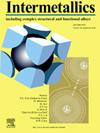Interfacial reaction and IMC growth kinetics at the Bi2Te3/Ag interface during isothermal aging
IF 4.3
2区 材料科学
Q2 CHEMISTRY, PHYSICAL
引用次数: 0
Abstract
Bonding materials that can withstand high operating temperatures are essential for increasing the conversion efficiencies of thermoelectric power-generation devices. Sn-based solders commonly used to join thermoelectric materials and electrodes have the disadvantage of limiting the maximum operating temperature to 150 °C because of their low melting point. To overcome this limitation, in the present study, Ag nanoparticle paste with high-temperature stability, low electrical resistivity, high thermal conductivity, and printability was used for bonding a Bi2Te3 thermoelectric material and an electroless nickel immersion gold (ENIG)-plated Cu electrode.
We performed isothermal aging at 200 °C from 0 to 1000 h to analyze the microstructural and thickness changes in intermetallic compounds (IMCs). Initially, a heterogeneous distribution of the IMC layers was observed at the bonding interface; over time, the IMC structures became clearly distinct. The IMC thickness increased from ≤3.0 μm (initial) to 45.6 μm in 1000 h, growing by a factor of approximately 15.2. We analyzed the growth kinetics of AgTe and BiTe IMCs. The growth exponent n of the AgTe IMC was found to be 0.3, indicating grain boundary diffusion with grain-growth control, whereas the n value of the BiTe IMC was 0.5, which is consistent with volumetric diffusion-controlled growth. These differences in the growth behavior indicate that different diffusion mechanisms affect the reliability and performance of the bonding interface.

等温老化过程中 Bi2Te3/Ag 界面的界面反应和 IMC 生长动力学
本文章由计算机程序翻译,如有差异,请以英文原文为准。
求助全文
约1分钟内获得全文
求助全文
来源期刊

Intermetallics
工程技术-材料科学:综合
CiteScore
7.80
自引率
9.10%
发文量
291
审稿时长
37 days
期刊介绍:
This journal is a platform for publishing innovative research and overviews for advancing our understanding of the structure, property, and functionality of complex metallic alloys, including intermetallics, metallic glasses, and high entropy alloys.
The journal reports the science and engineering of metallic materials in the following aspects:
Theories and experiments which address the relationship between property and structure in all length scales.
Physical modeling and numerical simulations which provide a comprehensive understanding of experimental observations.
Stimulated methodologies to characterize the structure and chemistry of materials that correlate the properties.
Technological applications resulting from the understanding of property-structure relationship in materials.
Novel and cutting-edge results warranting rapid communication.
The journal also publishes special issues on selected topics and overviews by invitation only.
 求助内容:
求助内容: 应助结果提醒方式:
应助结果提醒方式:


